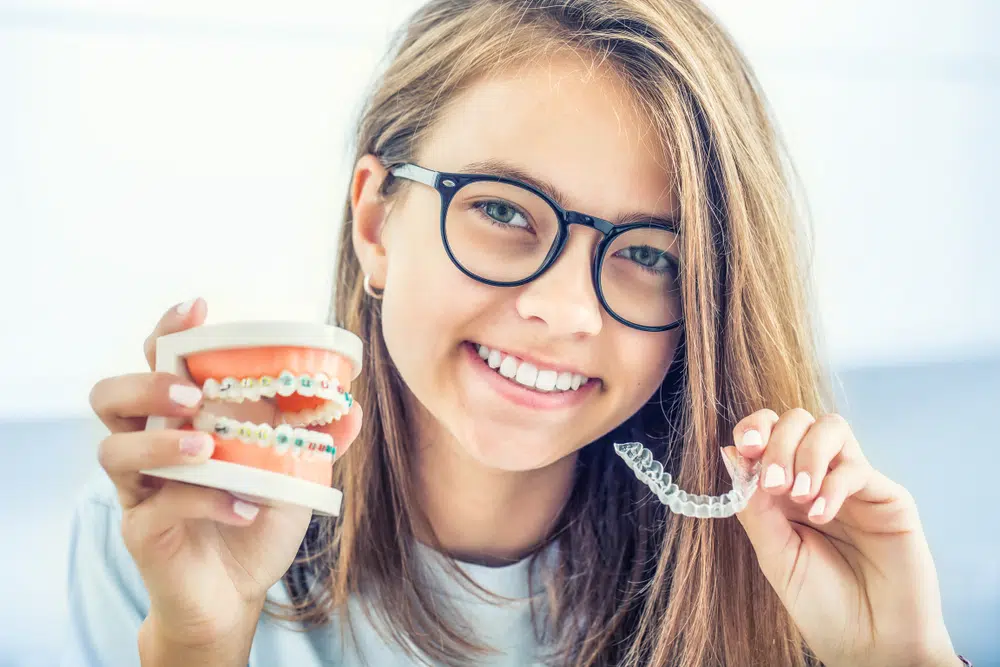A beautiful smile increases confidence and allows you to put your best foot forward. Many children, teens, and adults use orthodontics as a tool to transform their grins and get perfect teeth. Two of the most popular options for correction are Invisalign and traditional braces. What are the key differences between the two?
How Your Smile Appears During Treatment
One of the biggest reasons why people choose Invisalign over traditional braces is that clear aligners are virtually invisible when they are properly fitted and inside of your mouth. Braces are immediately visible when you speak and smile, and some people prefer to have a more subtle correction tool used. If you have major events coming up during your treatment period, like a wedding, and are a good candidate for both, Invisalign may be better.
Length of Treatment Time
Traditional braces can address much more severe alignment issues than Invisalign. As a result, treatment may stretch on for 1-3 years to ensure a beautiful smile in the end. Invisalign may be used in a broad range of cases, but it’s generally used for mild corrections. Your course of treatment with Invisalign can be as short as six months, but it will vary from case to case.
Removable or Permanent
Invisalign aligners can be removed from your mouth when you eat and drink for more comfort, which also allows you to clean your teeth more thoroughly when you brush and floss them. Braces are permanent for the course of your treatment, so you will need to adapt your diet, brushing, and flossing habits around them.
Maintenance During Treatment
Braces require regular cleaning to prevent discoloration of the teeth around the brackets, and you will also need to visit the orthodontist on a schedule to have adjustments performed as your smile shifts. Wearing braces also requires daily care in avoiding foods that often lead to bracket damage or discomfort, including:
- Popcorn
- Hard, crunchy fruits and vegetables
- Corn on the cob
- Caramel and sticky candy like gummies or taffy
- Crusty bread
- Nuts
- Pretzels and chips
Aligners have strict maintenance requirements as well. While you can remove them to eat and drink, they must be worn at least 22 hours every day and be cleaned when they are removed and put back in. If you are a snacker or someone who likes to sip on soda all day long, Invisalign may make that tougher.
Costs Can Vary
Both traditional braces and Invisalign are major investments in your oral health and your smile, so the total cost of treatment will start in the four figures. However, Invisalign treatments tend to cost more than similar treatments with traditional braces. For an accurate estimate of how much it would cost to have Invisalign in Surrey, you should schedule a consultation.
Personalization Options
While some people want to avoid traditional braces because they are visible, children and teens especially can enjoy having a fun accessory to customize during their treatment. The rubber bands placed on each bracket come in an endless range of colors, so they could have their school colors, favorite sports team colors, or other fun shades that show off their personality and interests. Invisalign aligners are always transparent and not customizable in that regard.
Insurance Coverage
If you have dental insurance that you plan on using to offset the cost of orthodontic treatment, you must check the requirements before choosing between Invisalign and traditional braces. Traditional braces are covered, at least partially, by most types of dental insurers. Invisalign is expanding in coverage, but a significant number of patients use financing to make it easier to cover the cost instead of insurance.
Effectiveness and Final Results
Traditional braces are relatively hands-off once you have them installed, as your orthodontist will be the one completing adjustments and they will be on your teeth 24 hours a day. Invisalign aligners require total buy-in from every patient, as you can remove them from your mouth if you are uncomfortable, forget to put them back in after eating, or leave one tray in for longer than necessary. While both methods get beautiful final results, Invisalign requires patients to stick to the process to ensure them.
 Existing Patient Login
604-542-8552
Free Consult
Virtual Consult
Existing Patient Login
604-542-8552
Free Consult
Virtual Consult
